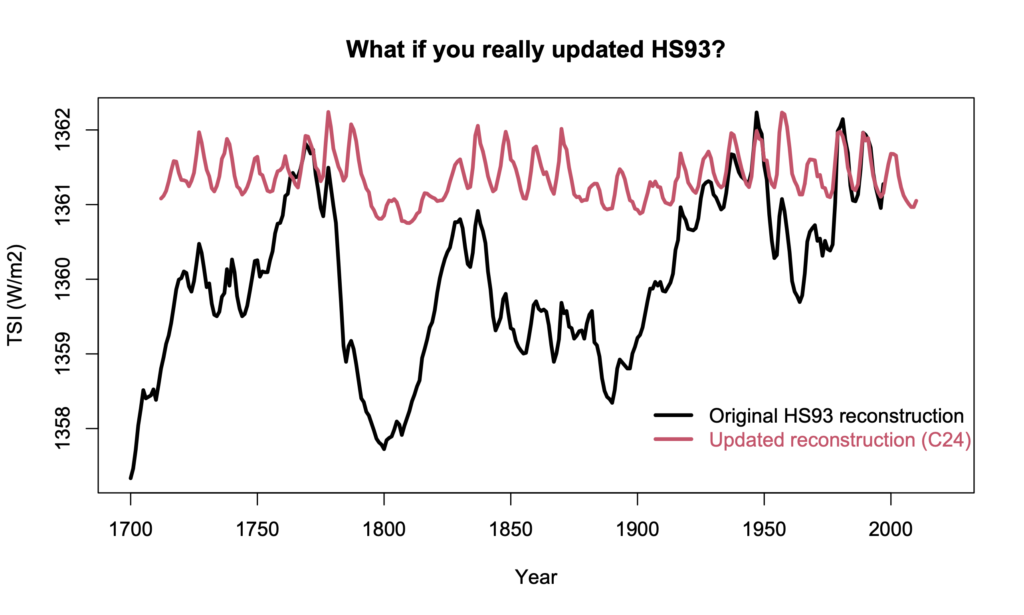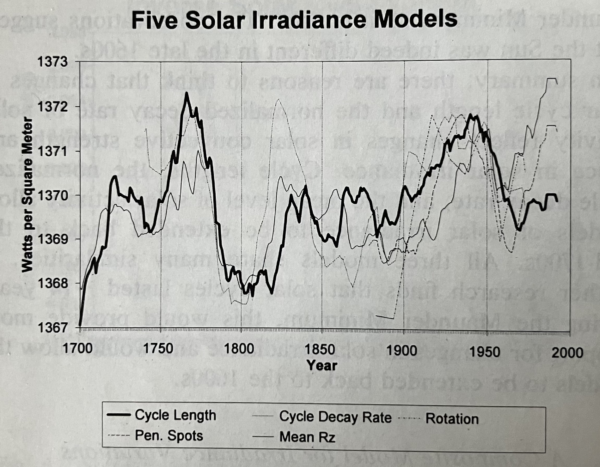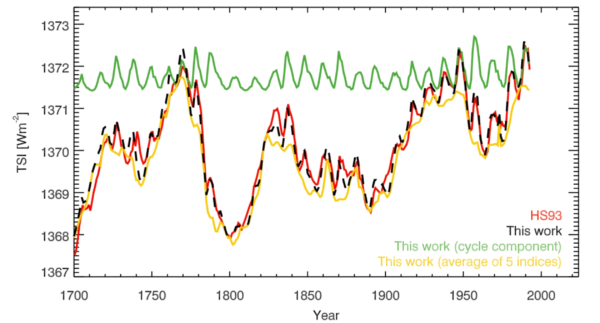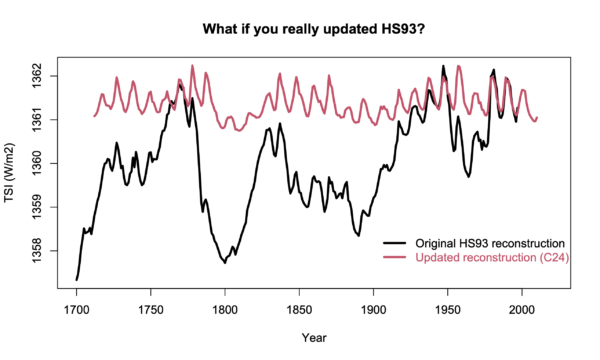RealClimate: More solar shenanigans*
5 min read
[*]
Going back a few months, I spent a bit of time pointing out the strategy and nonsense in the various Willie Soon and company’s efforts to blame current warming on solar activity. I specifically pointed out their cultish devotion to a single solar activity reconstruction (Hoyt and Schatten, 1993) (HS93); with an update from Scaffeta (2023), and their increasingly elaborate efforts to create temperature series that correlate to it.
Well, Theodosios Chatzistergos has just published a deep dive into the HS93 reconstruction (Chatzistergos, 2024) (C24) and… let’s say the results will not be surprising to regular readers.
In the beginning
The basic idea of HS93 was reasonable (IMO), to use multiple indices related to solar activity to create a composite reconstruction of Total Solar Irradiance (TSI) that would be more robust than one based on any single index which might have some specific issues. HS93 assembled five hypothesized time series: annual sunspot numbers (and an 11-yr smoothed version), the solar cycle length (SCL), solar-cycle decay rate, equatorial solar rotation, and the fraction of penumbral spots. As we discussed before, the SCL index was included because of the (then recent) result from Friis-Christensen and Lassen (1991) connecting SCL to temperature. However, as we discussed last time, this result was an artifact of the smoothing procedure (Laut, 2003) and despite some further efforts by those authors to rescue it, there turns out to be no relationship to temperature at all. Furthermore, the last index is rather poorly described and may just be noise. Each of the five indices was then scaled and merged. There was also a calibration of one of the free parameters to match a presumed Maunder Minimum value (but more on this later).
Chatzistergos was able to update and extend all of these data series to the present and use the HS93 procedure to make a new reconstruction. Ideally, this would have produced a reconstruction that resembled HS93, but extended to the near-present, but… this is not how it turned out.
In reproducing the methodology Chatzistergos discovered multiple inconsistencies, an undocumented implicit forecast of future solar cycles (which did not pan out), and a number of artifacts which served to produce a artificial positive trend from 1960 onward.
First, HS93 lagged the smoothed sunspot numbers by a full solar cycle, based on the assumption that the TSI lagged long-term smoothed sunspots (based on a suggestion in the literature at that time). However, in shifting the sunspots back 11 years, they needed to assume sunspot values for the future to predict TSI to 1992, and the way they chose to extend them was nowhere documented (but, in retrospect, it was clear in their figure 8). This component then ended up with a strong uptick from ~1960 to 1992 that was essentially invented.
How the extension was done is curious. C24 suggested that it was a linear extension of the previous decade, but I think that a closer inspection of their Figure 8 suggests that the extra years of the smoothed sunspots was just copied from the last 11 years of the fraction of penumbral spots offset to match the last actual sunspot value. I can think of no valid reason for this.

Second, the solar-cycle-decay time series also seems to have been offset by about 10 years (again undocumented). Third, the equatorial rotation rate was similarly difficult to reproduce. And finally, the creation of the fraction of penumbral spots was taken from two distinct datasets without consideration of the biases they may have had with respect to each other, which also created an artificial rise at the end of the time series. Overall, not an easy paper to replicate!
There is one further free parameter that sets the long term trend. In HS93, it is a little ambiguous, but in their book Hoyt and Schatten (1997) they say explicitly that it is based on Lean et al (1992), which in turn was based on a scaling of cycling to non-cycling stars from Baliunas and Jastrow (1990). I’ll note that this is what I said previously, but this was vigorously denied by Soon and colleagues in a recent blog post. (Forgive them, for they know not what they talk about).
Putting it all together
Chatzistergos was basically able to recreate something very close to the original HS93 (his figure 7b):

But he was also able to demonstrate the impact of the artifacts introduced at the time, as well as the impact of updates to the component datasets and a more appropriate long-term scaling. The results are impressively different:

Without the artificial boost in the sunspot numbers, and the mixing of disparate data sources in the penumberal spot fraction, and without the invalid long-term trend, surprisingly, the methods of HS93 would have given a reconstruction like most others. The trends would have been negative from the 1950s peak (as in the other reconstructions), and the search for temperature indices that matched it, would have been futile.
I predict that none of this will prevent Soon and colleagues continuing to cling to the original HS93, or it’s purported extension from Scafetta (which did not dig into the original methodology at all). But maybe they will surprise me. Maybe they will acknowledge the shenanigans and move on to more valid arguments? I won’t hold my breath.
[*] I realise I’m overusing the word shenanigans, but it’s alliterative and appropriate!
References
D.V. Hoyt, and K.H. Schatten, “A discussion of plausible solar irradiance variations, 1700‐1992”, Journal of Geophysical Research: Space Physics, vol. 98, pp. 18895-18906, 1993. http://dx.doi.org/10.1029/93JA01944
N. Scafetta, “Empirical assessment of the role of the Sun in climate change using balanced multi-proxy solar records”, Geoscience Frontiers, vol. 14, pp. 101650, 2023. http://dx.doi.org/10.1016/j.gsf.2023.101650
T. Chatzistergos, “A Discussion of Implausible Total Solar-Irradiance Variations Since 1700”, Solar Physics, vol. 299, 2024. http://dx.doi.org/10.1007/s11207-024-02262-6
D.V. Hoyt, and K.H. Shatten, “The Role of the Sun in Climate Change”, 1997. http://dx.doi.org/10.1093/oso/9780195094138.001.0001
J. Lean, A. Skumanich, and O. White, “Estimating the Sun’s radiative output during the Maunder Minimum”, Geophysical Research Letters, vol. 19, pp. 1591-1594, 1992. http://dx.doi.org/10.1029/92GL01578
S. Baliunas, and R. Jastrow, “Evidence for long-term brightness changes of solar-type stars”, Nature, vol. 348, pp. 520-523, 1990. http://dx.doi.org/10.1038/348520a0
[*]
[*]Source link




